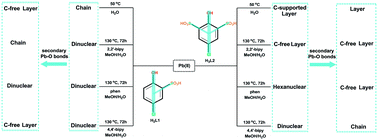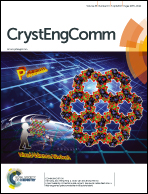Effect of ligand configurations, secondary Pb–O interactions and auxiliary ligands on Pb(ii)–mono/disulfonate complexes: syntheses, structures, and luminescence properties†
Abstract
Eight new Pb(II)–mono/disulfonate complexes, [Pb2(L1)2(H2O)]n (1), [Pb(L1)(2,2′-bipy)] (2), [Pb(L1)(phen)]·H2O (3), [Pb(L1)(H2O)]·0.5(4,4′-bipy) (4), [Pb(HL2)(H2O)3]n (5), [Pb4(L2)2(AcO)2(2,2′-bipy)(H2O)]n (6), [Pb3(L2)2(phen)(H2O)5]·2H2O (7) and [Pb(HL2)(4,4′-bipy)(H2O)]·H2O (8) (H2L1 = 2-hydroxy-5-chlorobenzenesulfonic acid, H3L2 = 2-hydroxy-5-chloro-1,3-benzenedisulfonic acid, phen = 1,10-phenanthroline, 2,2′-bipy = 2,2′-bipyridine, 4,4′-bipy = 4,4′-bipyridine, AcO− = acetate), have been synthesized by the reaction of a Pb(II) salt, mono- or disulfonate, with three N-heterocyclic auxiliary ligands and characterized by elemental analysis, IR, TG, PL, powder and single-crystal X-ray diffraction. With the primary Pb–O bonds, these eight complexes exhibit diverse dinuclear (2, 3, 4 and 8), hexanuclear (7), linear chain (1) and layer structures (5 and 6). The Pb(II) cations in these complexes present a hemidirected geometry, except for complex 6, in which the Pb(II) cations present rarely hemidirected and holodirected geometries in one system. Taking the secondary Pb–O bonds into account, chain structures for complexes 2 and 8 and layer motifs for complexes 1 and 4–7 are observed with the Pb(II) cations showing more intricate hemi- and holodirected geometries. Meanwhile, the disulfonate anions present more coordination sites to Pb(II) cations, thus leading to high-dimensional structures in comparison with the monosulfonate anions. Moreover, ligand configurations and the introduction of the N-heterocyclic auxiliary ligands also play important roles in modulating the structures of the Pb(II)–sulfonate complexes. Luminescence analyses indicate that complexes 6–8 present purple emission at 400, 397 and 399 nm at room temperature.



 Please wait while we load your content...
Please wait while we load your content...